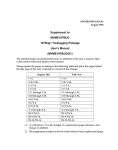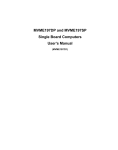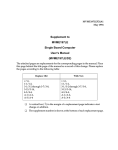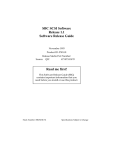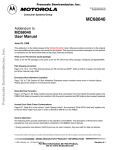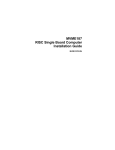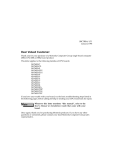Download Motorola MVME712AM Installation guide
Transcript
MVME197DP and MVME197SP Single Board Computers Installation Guide (MVME197IG/D1) Notice While reasonable efforts have been made to assure the accuracy of this document, Motorola, Inc. assumes no liability resulting from any omissions in this document, or from the use of the information obtained therein. Motorola reserves the right to revise this document and to make changes from time to time in the content hereof without obligation of Motorola to notify any person of such revision or changes. No part of this material may be reproduced or copied in any tangible medium, or stored in a retrieval system, or transmitted in any form, or by any means, radio, electronic, mechanical, photocopying, recording or facsimile, or otherwise, without the prior written permission of Motorola, Inc. It is possible that this publication may contain reference to, or information about Motorola products (machines and programs), programming, or services that are not announced in your country. Such references or information must not be construed to mean that Motorola intends to announce such Motorola products, programming, or services in your country. Restricted Rights Legend If the documentation contained herein is supplied, directly or indirectly, to the U.S. Government, the following notice shall apply unless otherwise agreed to in writing by Motorola, Inc. Use, duplication, or disclosure by the Government is subject to restrictions as set forth in subparagraph (c)(1)(ii) of the Rights in Technical Data and Computer Software clause at DFARS 252.227-7013. Motorola, Inc. Computer Group 2900 South Diablo Way Tempe, Arizona 85282-9602 Preface This document provides a general board level hardware description, hardware preparation and installation instructions, debugger general information, and instructions on using the debugger for the MVME197DP and MVME197SP versions of the MVME197 series of Single Board Computers. This document is intended for anyone who wants to design OEM systems, supply additional capability to an existing compatible system, or work in a lab environment for experimental purposes. A basic knowledge of computers and digital logic is assumed. To use this document, you may wish to become familiar with the publications listed in the Related Documentation section found in the following pages. This installation guide is based on these other documents. Document Terminology Throughout this document, a convention has been maintained whereby data and address parameters are preceded by a character which specifies the numeric format, as follows: $ dollar specifies a hexadecimal number % percent specifies a binary number & ampersand specifies a decimal number For example, “12” is the decimal number twelve, and “$12” is the decimal number eighteen. Unless otherwise specified, all address references are in hexadecimal throughout this document. An asterisk (*) following the signal name for signals which are level significant denotes that the signal is true or valid when the signal is low. An asterisk (*) following the signal name for signals which are edge significant denotes that the actions initiated by that signal occur on high to low transition. In this document, assertion and negation are used to specify forcing a signal to a particular state. In particular, assertion and assert refer to a signal that is active or true; negation and negate indicate a signal that is inactive or false. These terms are used independently of the voltage level (high or low) that they represent. Data and address sizes are defined as follows: ❏ A byte is eight bits, numbered 0 through 7, with bit 0 being the least significant. ❏ A two-byte is 16 bits, numbered 0 through 15, with bit 0 being the least significant. For the MVME197series and other RISC modules, this is called a half-word. ❏ A four-byte is 32 bits, numbered 0 through 31, with bit 0 being the least significant. For the MVME197 series and other RISC modules, this is called a word. ❏ An eight-byte is 64 bits, numbered 0 through 63, with bit 0 being the least significant. For the MVME197 series and other RISC modules, this is called a double-word. Throughout this document, it is assumed that the MPU on the MVME197 module series is always programmed with big-endian byte ordering, as shown below. Any attempt to use small-endian byte ordering will immediately render the MVME197Bug debugger unusable. BIT 63 56 55 ADRO 31 48 47 ADR1 24 23 ADR4 40 39 ADR2 16 15 ADR5 BIT 32 ADR3 08 07 ADR6 00 ADR7 The terms control bit and status bit are used extensively in this document. The term control bit is used to describe a bit in a register that can be set and cleared under software control. The term true is used to indicate that a bit is in the state that enables the function it controls. The term false is used to indicate that the bit is in the state that disables the function it controls. In all tables, the terms 0 and 1 are used to describe the actual value that should be written to the bit, or the value that it yields when read. The term status bit is used to describe a bit in a register that reflects a specific condition. The status bit can be read by software to determine operational or exception conditions. Related Documentation The following publications are applicable to the MVME197 module series and may provide additional helpful information. If not shipped with this product, they may be purchased by contacting your Motorola sales office. Document Title Motorola Publication Number MVME197LE Single Board Computer User’s Manual MVME197LE MVME197LE Single Board Computer Support Information SIMVME197LE MVME197DP and MVME197SP Single Board Computer User’s Manual MVME197 MVME197DP and MVME197SP Single Board Computer Support Information SIMVME197 MVME197LE, MVME197DP, and MVME197SP Single Board Computers Programmer’s Reference Guide MVME197PG MVME197BUG 197Bug Debugging Package User’s Manual MVME197BUG MVME197BUG 197Bug Diagnostic Firmware User’s Manual MVME197DIAG MVME712M Transition Module and P2 Adapter Board User’s Manual MVME712M MVME712-12, MVME712-13, MVME712A, MVME712AM, MVME712A and MVME712B Transition Module and LCP2 Adapter Board User’s Manual MC88110 Second Generation RISC Microprocessor User’s Manual MC88110UM MC68040 Microprocessor User’s Manual MC68040UM MC88410 Secondary Cache Controller User’s Manual MC88410UM N otes 1. The support information manuals (SIMVME197LE and SIMVME197) contain: the connector interconnect signal information, parts lists, and the schematics for the specific board(s) indicated. 2. Although not shown in the above list, each Motorola Computer Group manual publication number is suffixed with characters which represent the revision level of the document, such as “/D2” (the second revision of a manual); a supplement bears the same number as the manual but has a suffix such as “/A1” (the first supplement to the manual). To further assist your development effort, Motorola has collected user’s manuals for each of the peripheral controllers used on the MVME197 module series and other boards from the suppliers. This bundle includes manuals for the following: 68-1X7DS for use with the MVME197 series of Single Board Computers. NCR 53C710 SCSI Controller Data Manual and Programmer’s Guide Intel i82596 Ethernet Controller User’s Manual Cirrus Logic CD2401 Serial Controller User’s Manual SGS-Thompson MK48T08 NVRAM/TOD Clock Data Sheet The following non-Motorola publications may also be of interest and may be obtained from the sources indicated. The VMEbus Specification is contained in ANSI/IEEE Standard 1014-1987. ANSI/IEEE Std 1014-1987 Versatile Backplane Bus: VMEbus The Institute of Electrical and Electronics Engineers, Incorporated Publication and Sales Department 345 East 47th Street New York, New York 10017-2633 Telephone: 1-800-678-4333 ANSI Small Computer System Interface-2 (SCSI-2), Draft Document X3.131-198X, Revision 10c Global Engineering Documents P.O. Box 19539 Irvine, California 92713-9539 Telephone (714) 979-8135 The computer programs stored in the Read Only Memory of this device contain material copyrighted by Motorola Inc., first published 1991, and may be used only under license such as the License for Computer Programs (Article 14) contained in Motorola’s Terms and Conditions of Sale, Rev. 1/79. Motorola® and the Motorola symbol are registered trademarks of Motorola, Inc. Delta Series, M88000, SYSTEM V/88, VMEmodule, VMEsystem, and 197bug are trademarks of Motorola, Inc. Timekeeper and Zeropower are trademarks of Thompson Components. All other products mentioned in this document are trademarks or registered trademarks of their respective holders © Copyright Motorola 1994 All Rights Reserved Printed in the United States of America January 1994 ! WARNING This equipment generates, uses, and can radiate radio frequency energy and if not installed and used in accordance with the documentation for this product, may cause interference to radio communications. It has been tested and found to comply with the limits for a Class A Computing Device pursuant to Subpart J of Part 15 of FCC rules, which are designed to provide reasonable protection against such interference when operated in a commercial environment. Operation of this equipment in a residential area is likely to cause interference in which case the user, at the user’s own expense, will be required to take whatever measures necessary to correct the interference. SAFETY SUMMARY SAFETY DEPENDS ON YOU The following general safety precautions must be observed during all phases of operation, service, and repair of this equipment. Failure to comply with these precautions or with specific warnings elsewhere in this manual violates safety standards of design, manufacture, and intended use of the equipment. Motorola Inc. assumes no liability for the customer’s failure to comply with these requirements. The safety precautions listed below represent warnings of certain dangers of which we are aware. You, as the user of the product, should follow these warnings and all other safety precautions necessary for the safe operation of the equipment in your operating environment. GROUND THE INSTRUMENT. To minimize shock hazard, the equipment chassis and enclosure must be connected to an electrical ground. The equipment is supplied with a three-conductor ac power cable. The power cable must either be plugged into an approved three-contact electrical outlet or used with a three-contact to two-contact adapter, with the grounding wire (green) firmly connected to an electrical ground (safety ground) at the power outlet. The power jack and mating plug of the power cable meet international Electrotechnical Commission (IEC) safety standards. DO NOT OPERATE IN AN EXPLOSIVE ATMOSPHERE. Do not operate the equipment in the presence of flammable gases or fumes. Operation of any electrical equipment in such an environment constitutes a definite safety hazard. KEEP AWAY FROM LIVE CIRCUITS. Operating personnel must not remove equipment covers. Only Factory Authorized Service Personnel or other qualified maintenance personnel may remove equipment covers for internal subassembly or component replacement or any internal adjustment. Do not replace components with power cable connected. Under certain conditions, dangerous voltages may exist even with the power cable removed. To avoid injuries, always disconnect power and discharge circuits before touching them. DO NOT SERVICE OR ADJUST ALONE. Do not attempt internal service or adjustment unless another person, capable of rendering first aid and resuscitation, is present. USE CAUTION WHEN EXPOSING OR HANDLING THE CRT. Breakage of the Cathode-Ray Tube (CRT) causes a high-velocity scattering of glass fragments (implosion). To prevent CRT implosion, avoid rough handling or jarring of the equipment. Handling of the CRT should be done only by qualified maintenance personnel using approved safety mask and gloves. DO NOT SUBSTITUTE PARTS OR MODIFY EQUIPMENT. Because of the danger of introducing additional hazards, do not install substitute parts or perform any unauthorized modification of the equipment. Contact your local Motorola representative for service and repair to ensure that safety features are maintained. DANGEROUS PROCEDURE WARNINGS. Warnings, such as the example below, precede potentially dangerous procedures throughout this manual. Instructions contained in the warnings must be followed. You should also employ all other safety precautions which you deem necessary for the operation of the equipment in your operating environment. ! WARNING Dangerous voltages, capable of causing death, are present in this equipment. Use extreme caution when handling, testing, and adjusting. SPD 15163 R-2 (9/93) Contents CHAPTER 1 BOARD LEVEL HARDWARE DESCRIPTION Introduction ................................................................................................................ 1-1 Model Designations ................................................................................................... 1-1 Overview ..................................................................................................................... 1-2 Requirements .............................................................................................................. 1-3 Features........................................................................................................................ 1-3 Block Diagrams........................................................................................................... 1-5 Functional Description .............................................................................................. 1-8 Front Panel Switches and Indicators................................................................ 1-8 Data Bus Structure .............................................................................................. 1-9 MC88110 MPU..................................................................................................... 1-9 MC88410 Cache Controller................................................................................ 1-9 BOOT ROM.......................................................................................................... 1-9 Flash Memory...................................................................................................... 1-9 Onboard DRAM ................................................................................................ 1-10 Battery Backup RAM and Clock..................................................................... 1-10 VMEbus Interface ............................................................................................. 1-10 I/O Interfaces .................................................................................................... 1-11 Serial Port Interface ................................................................................... 1-11 Printer Interface ......................................................................................... 1-11 Ethernet Interface....................................................................................... 1-12 SCSI Interface ............................................................................................. 1-12 SCSI Termination....................................................................................... 1-13 Peripheral Resources ........................................................................................ 1-13 Programmable Tick Timers...................................................................... 1-13 Watchdog Timer ........................................................................................ 1-13 Software-Programmable Hardware Interrupts..................................... 1-13 Processor Bus Timeout.............................................................................. 1-14 Local Peripheral Bus Timeout.................................................................. 1-14 Interrupt Sources............................................................................................... 1-14 Connectors ......................................................................................................... 1-14 Memory Maps .......................................................................................................... 1-15 Processor Bus Memory Map ........................................................................... 1-15 VMEbus Memory Map..................................................................................... 1-18 VMEbus Accesses to the Local Peripheral Bus...................................... 1-18 VMEbus Short I/O Memory Map ........................................................... 1-18 ix CHAPTER 2 HARDWARE PREPARATION AND INSTALLATION Introduction .................................................................................................................2-1 Unpacking Instructions..............................................................................................2-1 Hardware Preparation ...............................................................................................2-1 Configuration Switches ......................................................................................2-3 Configuration Switch S1: General Information .......................................2-3 Configuration Switch S1: General Purpose Functions (S1-1 to S1-8) ......................................................................................2-4 Configuration Switch S1: System Controller Enable Function (S1-9) ..................................................................................2-4 Configuration Switch S6: Serial Port 4 Clock Select (S6-1, S6-2)..........................................................................................2-5 Installation Instructions .............................................................................................2-5 MVME197 Module Installation .........................................................................2-6 System Considerations .......................................................................................2-7 CHAPTER 3 DEBUGGER GENERAL INFORMATION Overview of M88000 Firmware ................................................................................3-1 Description of 197Bug ................................................................................................3-1 Comparison With M68000-Based Firmware...........................................................3-2 197Bug Implementation.............................................................................................3-2 FLASH-Based Debugger ....................................................................................3-2 BOOT ROM ..........................................................................................................3-3 Setup System Parameters SETUP ..............................................................3-5 Execute User Program EXEC [ADDR] ......................................................3-6 Installation and Start-Up ...........................................................................................3-6 Autoboot ......................................................................................................................3-8 ROMboot......................................................................................................................3-9 Network Boot ..............................................................................................................3-9 Restarting the System...............................................................................................3-10 Reset ....................................................................................................................3-10 Double-Button Reset .........................................................................................3-11 Abort....................................................................................................................3-12 Break ....................................................................................................................3-12 SYSFAIL* Assertion/Negation........................................................................3-12 MPU Clock Speed Calculation ........................................................................3-13 Memory Requirements ............................................................................................3-13 Terminal Input/Output Control......................................................................3-13 Disk I/O Support......................................................................................................3-14 x Blocks Versus Sectors........................................................................................ 3-15 Device Probe Function ..................................................................................... 3-15 Disk I/O via 197Bug Commands ................................................................... 3-15 IOI (Input/Output Inquiry) ..................................................................... 3-16 IOP (Physical Input/Output to Disk) ..................................................... 3-16 IOT (Input/Output Teach)....................................................................... 3-16 IOC (Input/Output Control) ................................................................... 3-16 BO (Bootstrap Operating System) ........................................................... 3-16 BH (Bootstrap and Halt) ........................................................................... 3-16 Disk I/O via 197Bug System Calls .......................................................... 3-16 Default 197Bug Controller and Device Parameters ..................................... 3-17 Disk I/O Error Codes ....................................................................................... 3-18 Network I/O Support ...................................................................................... 3-18 Physical Layer Manager Ethernet Driver............................................... 3-18 UDP/IP Protocol Modules ....................................................................... 3-19 RARP/ARP Protocol Modules ................................................................ 3-19 BOOTP Protocol Module.......................................................................... 3-19 TFTP Protocol Module .............................................................................. 3-19 Network Boot Control Module................................................................ 3-19 Network I/O Error Codes ........................................................................ 3-20 Multiprocessor Support .......................................................................................... 3-20 Multiprocessor Control Register (MPCR) Method ...................................... 3-20 GCSR Method.................................................................................................... 3-22 Diagnostic Facilities ................................................................................................. 3-22 CHAPTER 4 USING THE 197Bug DEBUGGER Entering Debugger Command Lines ...................................................................... 4-1 Syntactic Variables .............................................................................................. 4-2 Expression as a Parameter.......................................................................... 4-2 Address as a Parameter .............................................................................. 4-4 Address Formats.......................................................................................... 4-4 Offset Registers ............................................................................................ 4-4 Port Numbers ...................................................................................................... 4-5 Entering and Debugging Programs......................................................................... 4-5 Calling System Utilities From User Programs ....................................................... 4-6 Preserving The Debugger Operating Environment .............................................. 4-6 197Bug Vector Table and Workspace................................................................ 4-6 Hardware Functions ........................................................................................... 4-6 Exception Vectors Used by 197Bug .................................................................. 4-6 CPU/MPU Registers .......................................................................................... 4-7 xi Floating Point Support...............................................................................................4-7 Single Precision Real ...........................................................................................4-8 Double Precision Real .........................................................................................4-8 Scientific Notation ...............................................................................................4-8 197Bug Debugger Command Set .............................................................................4-9 APPENDIX A CONFIGURE AND ENVIRONMENT COMMANDS Configure Board Information Block........................................................................A-1 Set Environment to Bug/Operating System..........................................................A-2 APPENDIX B DISK/TAPE CONTROLLER DATA Disk/Tape Controller Modules Supported............................................................ B-1 Disk/Tape Controller Default Configurations ...................................................... B-2 IOT Command Parameters for Supported Floppy Types.................................... B-5 APPENDIX C NETWORK CONTROLLER DATA Network Controller Modules Supported...............................................................C-1 xii List of Figures Figure 1-1. MVME197SP Block Diagram ................................................................ 1-6 Figure 1-2. MVME197DP Block Diagram ............................................................... 1-7 Figure 2-1. MVME197DP/SP Switches, Connectors, and LED Indicators Location Diagram........................................................................... 2-2 xiii xiv List of Tables Table 1-1. MVME197DP/SP Model Designations................................................. 1-1 Table 1-2. MVME197DP/SP Specifications ............................................................ 1-5 Table 1-3. Processor Bus Memory Map ................................................................. 1-16 Table 1-4. Local Devices Memory Map ................................................................. 1-17 Table 4-1. Debugger Commands.............................................................................. 4-9 Table A-1. ENV Command Parameters ................................................................. A-3 xv xvi BOARD LEVEL HARDWARE DESCRIPTION 1 Introduction This chapter describes the board level hardware features of the MVME197DP and MVME197SP versions of the MVME197 series of Single Board Computers, hereafter referred to as the MVME197, unless separately specified (refer to the next section for model designations). The chapter is organized with a board level overview and features listed in this introduction, followed by a more detailed hardware functional description. Front panel switches and indicators are included in the detailed hardware functional description. This chapter closes with some general memory maps. All programmable registers used in the MVME197 module series reside in ASIC (Application-Specific Integrated Circuit) devices that are covered in the MVME197LE, MVME197DP, and MVME197SP Single Board Computers Programmer’s Reference Guide. Model Designations The MVME197DP/SP module series of the Single Board Computers are available in the following models. Table 1-1. MVME197DP/SP Model Designations Model Number Motorola Part Number Model Description MVME197SP series MVME197-101 01-W3815B02 Single Processor MC88110, 256KB Cache, 128MB Onboard ECC DRAM, 50 MHz MVME197DP series MVME197-201 01-W3815B01 Dual Processor MC88110, 256KB Cache per Processor, 128MB Onboard ECC DRAM, 50 MHz MVME197-202 01-W3815B03 Dual Processor MC88110, 256KB Cache per Processor, 256MB Onboard ECC DRAM, 50 MHz MVME197IG/D1 1-1 1 Board Level Hardware Description Overview Each MVME197 module is a double-high VMEmodule based on the MC88110 RISC (Reduced Instruction Set Computer) microprocessor. The MVME197DP/SP module series have 128/256MB of onboard DRAM with programmable ECC (Error Checking and Correction), 256KB of external cache memory for each MC88110/MC88410 microprocessor/cache controller combination (note that the MVME197SP version has only one MC88110/ MC88410 device combination), 1MB of flash memory, 8KB of static RAM (with battery backup), a time of day clock (with battery backup), an Ethernet transceiver interface, four serial ports with EIA-232-D interface, six tick timers, a watchdog timer, 128/256KB of BOOT ROM, a SCSI bus interface with DMA (Direct Memory Access), a Centronics printer port, an A16/A24/A32/D8/ D16/D32 VMEbus master/slave interface, and a VMEbus system controller. Input/Output (I/O) signals are routed through the MVME197’s backplane connector P2. A P2 Adapter Board or LCP2 Adapter board routes the signals and grounds from connector P2 to an MVME712 series transition module. The MVME197 supports the MVME712M, MVME712A, MVME712AM, and MVME712B transition boards (referred to here as the MVME712X, unless separately specified). The MVME197 also supports the MVME712-12 and MVME712-13 (referred to as the MVME712-XX, unless separately specified). These transition boards provide configuration headers, serial port drivers, and industry standard connectors for the I/O devices. The MVME197 modules have eight ASIC devices (described in the following order: BusSwitch, DCAM, ECDM, PCC2, and VME2). N ote For the MVME197 series, the term Local Bus, as used in other MVME1xx Single Board Computer series, is referred to as the Local Peripheral Bus. The BusSwitch ASIC provides an interface between the processor bus (MC88110/410 bus) and the local peripheral bus (MC68040 compatible bus). Refer to the board specific MVME197 block diagram (Figure 1-1 and 1-2). It provides bus arbitration for the MC88410 bus and serves as a seven level interrupt handler. It has programmable map decoders for both busses, as well as write post buffers on each, two tick timers, and four 32-bit general purpose registers. The DCAM (DRAM Controller and Address Multiplexer) ASIC provides the address multiplexers and RAS/CAS/WRITE control for the DRAM as well as data control for the ECDM. 1-2 Installation Guide Requirements The ECDM (Error Correction and Data Multiplexer) ASIC multiplexes between four data paths on the DRAM array. Since the device handles 16 bits, four such devices are required on the MVME197 to accommodate the 64-bit data bus of the MC88110 RISC microprocessor. Single-bit error correction and double-bit detection is performed in the ECDM. The PCCchip2 (Peripheral Channel Controller) ASIC provides two tick timers and the interface to the LAN chip, the SCSI chip, the serial port chip, the printer port, and the BBRAM (Battery Backup RAM). The VMEchip2 ASIC provides a VMEbus interface. The VMEchip2 includes two tick timers, a watchdog timer, programmable map decoders for the master and slave interfaces, and a VMEbus to/from the local peripheral bus DMA controller, a VMEbus to/from the local peripheral bus non-DMA programmed access interface, a VMEbus interrupter, a VMEbus system controller, a VMEbus interrupt handler, and a VMEbus requester. The local peripheral bus to VMEbus transfers can be D8, D16, or D32. VMEchip2 DMA transfers to the VMEbus, however, can be 64 bits wide as Block Transfer (BLT). Requirements All MVME197 boards are designed to conform to the requirements of the following documents: ❏ VMEbus Specification (IEEE 1014-87) ❏ EIA-232-D Serial Interface Specification, EIA ❏ SCSI Specification, ANSI Features These are some of the major features of the MVME197DP/SP single board computers: ❏ Single MC88110 RISC Microprocessor with an MC88410 Cache Controller (MVME197SP module series) ❏ Dual MC88110 RISC Microprocessors, each with one MC88410 Cache Controller (MVME197DP module series) ❏ 256 kilobytes of external cache per processor, controlled by the MC88410 (MVME197DP and MVME197SP module series) ❏ 128 or 256 megabytes of 64-bit Dynamic Random Access Memory (DRAM) with Error Checking and Correction (ECC) MVME197IG/D1 1-3 1 1 Board Level Hardware Description ❏ 1 megabyte of Flash memory ❏ Six status LEDs (FAIL, RUN, SCON, LAN, SCSI, and VME) ❏ 8 kilobytes of Static Random Access Memory (SRAM) and Time of Day (TOD) clock with Battery Backup RAM (BBRAM) ❏ Two push-button switches (ABORT and RESET) ❏ 128 or 256 kilobytes of BOOT ROM ❏ Six 32-bit tick timers for periodic interrupts ❏ Watchdog timer ❏ Eight software interrupts ❏ I/O – – – – ❏ SCSI Bus interface with Direct Memory Access (DMA) Four serial ports with EIA-232-D buffers Centronics printer port Ethernet transceiver interface VMEbus interface – – – VMEbus system controller functions VMEbus interface to local peripheral bus (A24/A32, D8/D16/D32 BLT (D8/D16/D32/D64))(BLT = Block Transfer) Local peripheral bus to VMEbus interface (A24/A32, D8/D16/D32 BLT (D16/D32/D64)) – VMEbus interrupter – VMEbus interrupt handler – Global CSR for inter-processor communications – DMA for fast local memory - VMEbus transfers (A16/A24/A32, D16/D32 BLT (D16/D32/D64)) Specifications The specifications for the MVME197DP/SP are listed in the following table. 1-4 Installation Guide Block Diagrams Table 1-2. MVME197DP/SP Specifications Characteristics Specifications Power requirements +5 Vdc (+/- 2.5%), 4.8 A (typical), 5.8 A (maximum) +12 Vdc (+/- 2.5%), 100 mA (maximum) -12 Vdc (+/- 2.5%), 100 mA (maximum) Operating temperature 0˚ to 55˚ C at point of entry of forced air (approximately 490 LFM) Storage temperature -40˚ to 85˚ C Relative humidity 5% to 90% (non-condensing) Physical dimensions: PC board Height Width Thickness Double-high VMEboard PC board with connectors and front panel Height Width Thickness Board connectors: P1 connector 9.187 inches (233.35 mm) 6.299 inches (160.00 mm) 0.063 inch (1.60 mm) 10.309 inches (261.85 mm) 7.4 inches (188.00 mm) 0.80 inch (20.32 mm) A 96-pin connector which provides the interface to the VMEbus signals. P2 connector A 96-pin connector which provides the interface to the extended VMEbus signals and other I/O signals. J1 connector A 249-pin connector which provides the interface to the MC88110 address, data, and control signals to and from the mezzanine memory expansion. J4 connector Connector pins not used, all ten pin sockets are soldered over. Block Diagrams General block diagrams for the MVME197DP/SP are provided as follows. Figure 1-1 illustrates the block diagram for the MVME197SP and Figure 1-2 illustrates the block diagram for the MVME197DP. MVME197IG/D1 1-5 1 1 256KB Cache MC88410 Addr 32 Data DCAM 64 MUX Address RAS, CAS Address Bus PROCESSOR BUS Data Bus Mezzanine Port BusSwitch Addr 32 Data ECDM (X4) I2C Bus 256 I2C EEPROM 32 LOCAL PERIPHERAL BUS Address Bus Data Bus Memory Array 128 MB NVRAM/RTC Data Bus BOOT ROM Installation Guide VMEbus (VMEchip2) LAN 82596CA SCSI -II NCR53710 Flash Memory PCCchip2 Figure 1-1. MVME197SP Block Diagram 4 Serial Ports CL-CD2401 Board Level Hardware Description 1-6 MC88110 MVME197IG/D1 MC88110 MC88110 256KB Cache 256KB Cache MC88410 Addr MC88410 32 Data DCAM 64 MUX Address RAS, CAS Address Bus PROCESSOR BUS Data Bus Mezzanine Port BusSwitch Addr 32 Data ECDM (X4) I 2C Bus 256 I 2C EEPROM 32 LOCAL PERIPHERAL BUS Address Bus Data Bus Memory Array 128/256 MB NVRAM/RTC Data Bus VMEbus (VMEchip2) LAN 82596CA SCSI -II NCR53710 Flash Memory PCCchip2 1-7 Figure 1-2. MVME197DP Block Diagram 4 Serial Ports CL-CD2401 Block Diagrams BOOT ROM 1























